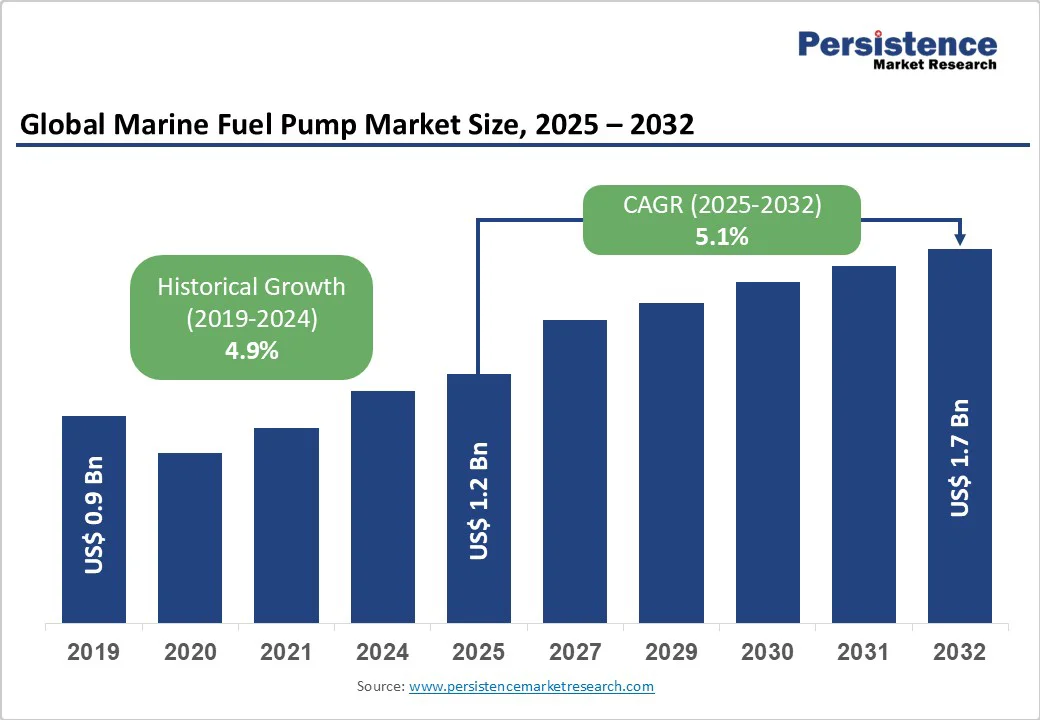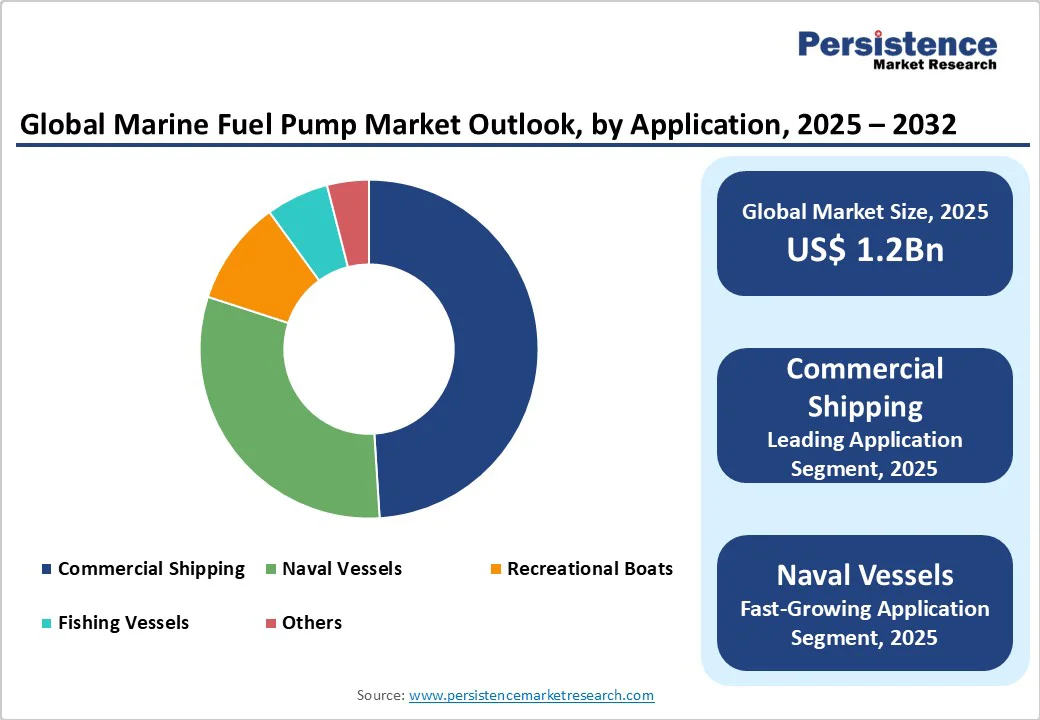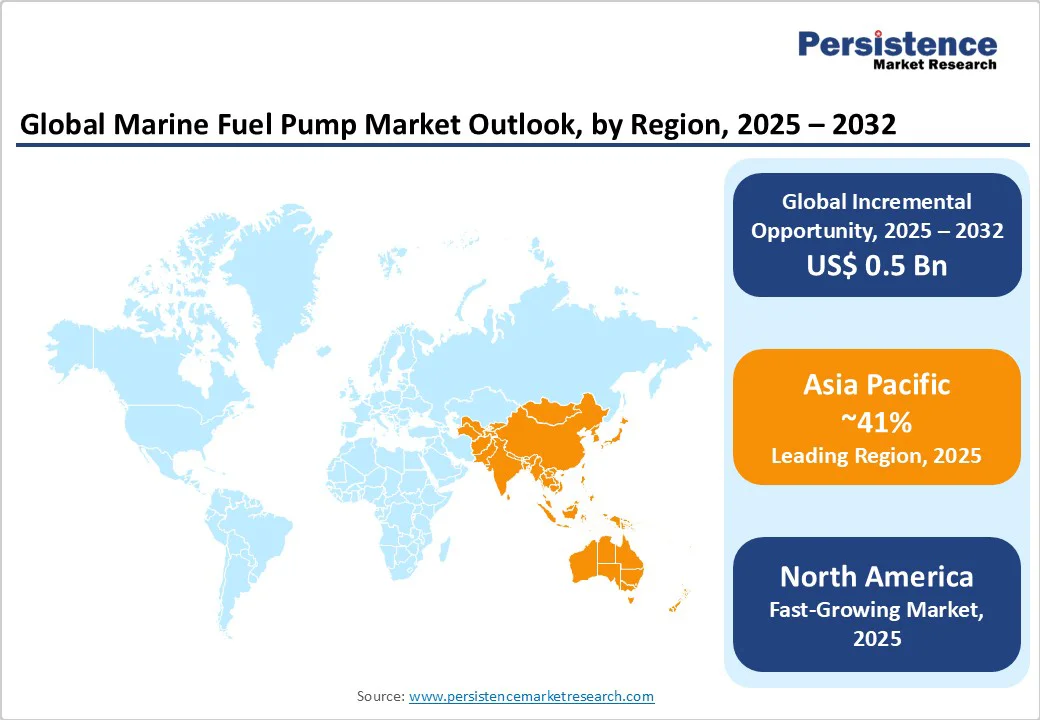ID: PMRREP31100| 189 Pages | 9 Oct 2025 | Format: PDF, Excel, PPT* | Industrial Automation

The global marine fuel pump market size is likely to be valued at US$ 1.2 Billion in 2025 and is projected to reach US$ 1.7 Billion by 2032, growing at a CAGR of 5.1% during the forecast period from 2025 to 2032, driven by the rising demand for efficient fuel delivery systems in marine vessels, advancements in fuel pump technologies, and the increasing adoption of cleaner fuel alternatives in response to stringent environmental regulations.
| Key Insights | Details |
|---|---|
|
Marine Fuel Pump Market Size (2025E) |
US$ 1.2 Bn |
|
Market Value Forecast (2032F) |
US$ 1.7 Bn |
|
Projected Growth (CAGR 2025 to 2032) |
5.1% |
|
Historical Market Growth (CAGR 2019 to 2024) |
4.9% |

The marine fuel pump market is significantly driven by the rapid growth of global maritime trade. Increasing international trade volumes, fueled by expanding e-commerce, industrial goods, and raw material transportation, have led to a surge in the number and capacity of commercial vessels. For instance, Maersk Line and COSCO Shipping have been expanding their container fleets to meet rising global demand, which directly increases the need for efficient fuel delivery systems. Container ships, bulk carriers, tankers, and offshore support vessels all rely heavily on reliable marine fuel pumps to ensure smooth engine operation and optimal fuel efficiency.
Environmental regulations such as the IMO 2020 sulphur cap and regional emission standards in Europe, North America, and the Asia Pacific are pushing vessel operators to adopt cleaner fuels and advanced fuel handling systems. For example, major operators such as NYK Line and Carnival Corporation have upgraded engines and fuel systems to comply with low-sulphur fuel mandates, requiring pumps capable of handling low-sulphur fuels, biofuels, and LNG. The dual pressure of rising trade volumes and stringent environmental compliance ensures continuous demand for innovative, durable, and efficient marine fuel pump solutions across all vessel types.
The high costs associated with developing and installing advanced marine fuel pump systems pose a significant restraint on market growth. Modern pumps, designed to handle low-sulphur fuels, advanced biofuels, and LNG, incorporate specialized materials, precision-engineered components, and often digital or IoT-enabled monitoring systems. These features significantly increase both initial purchase and installation costs compared to conventional pumps. For instance, pumps with corrosion-resistant alloys, variable flow control, and real-time diagnostics can be substantially more expensive, creating a financial barrier for smaller shipping companies and vessel operators.
The integration of emission-compliant technology to meet IMO 2020 regulations or regional standards in Europe and North America requires additional engineering, testing, and certification, further driving up costs. Retrofitting older vessels with advanced pumps adds not only equipment costs but also labor and downtime expenses, impacting operational budgets. These high expenditures can delay adoption, particularly in markets where shipping margins are thin or investment budgets are limited. Consequently, while the demand for advanced marine fuel pumps is growing, cost sensitivity among operators remains a significant challenge, restraining faster market penetration and adoption of next-generation pump technologies.
Advancements in eco-friendly and smart fuel pump technologies present significant growth opportunities for the marine fuel pump market. The development of fuel pumps compatible with alternative fuels, such as LNG and biodiesel, is gaining traction as the maritime industry transitions toward sustainability. For instance, companies such as Rolls-Royce have introduced fuel pump systems designed for LNG-powered vessels, which reduce carbon emissions and comply with IMO regulations. Additionally, the integration of smart technologies, such as IoT-enabled sensors and AI-driven monitoring, enhances fuel pump efficiency by enabling real-time diagnostics, predictive maintenance, and optimized fuel delivery.
These innovations reduce operational costs and improve vessel performance, making them attractive to commercial operators and naval fleets. The growing adoption of hybrid and electric propulsion systems in recreational and commercial vessels further opens avenues for fuel pump manufacturers to develop compact, energy-efficient solutions, driving long-term market growth.
Marine diesel oil dominates the marine fuel pump market, expected to account for approximately 45% share in 2025. Its dominance stems from its widespread use in commercial shipping, cost-effectiveness, and compatibility with a wide range of vessel types. MDO fuel pumps, offered by companies such as Woodward Inc. and Cummins Inc., are designed for high reliability and efficiency, supporting the demands of large-scale maritime operations. Their robust design ensures seamless fuel delivery, reducing downtime and maintenance costs.
The liquefied natural gas segment is the fastest-growing, driven by the global push for cleaner fuels and stricter environmental regulations. LNG fuel pumps offer enhanced efficiency and reduced emissions, making them ideal for modern vessels aiming to comply with the IMO’s sulfur cap and carbon reduction goals. The increasing number of LNG-powered vessels, particularly in Europe and the Asia Pacific, is accelerating the adoption of specialized fuel pumps in this segment.
Commercial shipping leads the marine fuel pump market, holding a 49% share in 2025. The segment’s dominance is driven by the critical role of fuel pumps in ensuring efficient fuel delivery for large cargo ships, container vessels, and tankers. Companies such as Caterpillar Inc. and MAN SE provide advanced fuel pump solutions that enhance fuel efficiency and reduce operational costs, supporting the global maritime trade boom.
The naval vessels segment is the fastest-growing, fueled by increasing government investments in naval modernization and defense. Advanced fuel pumps are critical for high-performance naval ships, enabling precise fuel management for complex propulsion systems. The rise in defense budgets in regions such as North America and the Asia Pacific, coupled with the need for fuel-efficient and reliable systems, is driving rapid adoption in this segment.
Direct sales hold the largest market share, accounting for approximately 44% of revenue. Direct sales allow manufacturers such as Rolls-Royce and Liebherr to maintain close relationships with shipbuilders and operators, offering customized fuel pump solutions and dedicated support. This channel is particularly dominant in commercial shipping and naval applications, where tailored solutions are critical.
Online sales are the fastest-growing distribution channel, driven by the increasing digitalization of the marine industry and the rise of e-commerce platforms. Online sales offer convenience, competitive pricing, and access to a wide range of fuel pump products, appealing to smaller operators and recreational boat owners. The growing adoption of digital procurement platforms by SMEs and startups is further accelerating this segment’s growth.

North American marine fuel pump market is a fast-growing market driven by a combination of advanced shipbuilding, fleet modernization, stringent environmental regulations, and high adoption of efficient fuel handling systems. The region is home to major shipbuilding hubs in the United States and Canada, producing commercial vessels, offshore support ships, and naval vessels that require reliable and high-performance fuel pumps. Increasing investments in building larger, more energy-efficient ships have heightened the demand for pumps that ensure precise fuel delivery, optimal engine performance, and minimal operational downtime. Fleet modernization initiatives across North America are another key growth factor.
Older vessels are being retrofitted or replaced with modern ships equipped with advanced fuel systems to improve efficiency, reduce maintenance, and comply with updated emission standards. Regulatory frameworks, including IMO 2020 sulphur cap compliance and stricter EPA marine fuel guidelines, are compelling operators to adopt eco-friendly and low-emission fuel pumps, driving demand for technologically advanced systems.
North American operators are increasingly implementing smart and IoT-enabled fuel pumps that offer real-time monitoring, predictive maintenance, and flow optimization, enhancing operational efficiency and reducing fuel costs. Collectively, these factors are sustaining growth and positioning North America as a key market for marine fuel pump technologies.
Europe is a significant player in the marine fuel pump market, supported by strong maritime traditions and advanced shipbuilding industries. Leading countries such as Germany, Norway, and the Netherlands drive market growth through extensive investments in green shipping technologies and alternative fuels.
The European Union’s stringent environmental regulations, such as the EU Green Deal and IMO 2020, are accelerating the adoption of fuel pumps compatible with MGO and LNG. Companies such as Rolls-Royce and MAN SE are at the forefront, developing innovative fuel pump systems for LNG-powered and hybrid vessels. Norway’s leadership in sustainable maritime solutions, particularly in LNG and biodiesel-powered ferries, is a key driver. The region’s focus on reducing carbon emissions and enhancing fuel efficiency through smart technologies further strengthens Europe’s market position, ensuring steady growth in the forecast period.
Asia Pacific is expected to hold an estimated 41% share of the global marine fuel pump market in 2025, making it one of the most significant and fastest-growing regions. The region’s growth is fueled by its strong shipbuilding industries, particularly in China, Japan, and South Korea, which are leading global production of container ships, bulk carriers, and LNG-powered vessels. The demand for high-performance fuel pumps is rising as these vessels require efficient and reliable fuel delivery systems for smooth operations.
Offshore oil and gas expansion across countries such as China, India, and Indonesia is contributing to market growth. Offshore platforms and support vessels require durable and precise fuel pumps capable of handling various fuel types under harsh conditions. Fleet modernization initiatives across the region are also driving the adoption of advanced marine fuel pumps to replace outdated systems, improving efficiency and reducing maintenance costs. Compliance with IMO 2020 emission standards and other environmental regulations further boosts the sector, as operators invest in pumps compatible with low-sulphur fuels, biofuels, and LNG. The combination of industrial growth, fleet upgrades, and regulatory adherence positions Asia Pacific as a key hub for marine fuel pump deployment, ensuring sustained market expansion.

The global marine fuel pump market is characterized by intense competition, regional strengths, and a mix of global and niche players. In developed regions such as North America and Europe, large firms such as Woodward Inc., Cummins Inc., and Rolls-Royce Holdings Plc dominate through scale, advanced R&D capabilities, and strong partnerships with shipbuilders and operators. In the Asia Pacific, rapid maritime developments and increasing demand for eco-friendly fuel pumps are attracting investments from both international players, such as MAN SE and Liebherr International AG, and regional vendors. Companies are focusing on product innovation, such as smart and eco-friendly fuel pump designs, and strategic alliances to gain a competitive edge. The development of fuel pumps for alternative fuels such as LNG and biodiesel has emerged as a key differentiator, enabling faster adoption in commercial and naval applications. Strategic collaborations, acquisitions, and digital-first approaches for supply chain and marketing are further intensifying the competitive landscape.
The global marine fuel pump market is projected to reach US$ 1.2 Bn in 2025.
The rising global maritime trade and stringent environmental regulations are key drivers.
The marine fuel pump market is poised to witness a CAGR of 5.1% from 2025 to 2032.
Advancements in eco-friendly and smart fuel pump technologies are a key opportunity.
Woodward Inc., Cummins Inc., Rolls-Royce Holdings Plc., and MAN SE are among the key players.
| Report Attribute | Details |
|---|---|
|
Historical Data/Actuals |
2019 - 2024 |
|
Forecast Period |
2025 - 2032 |
|
Market Analysis |
Value: US$ Bn, Volume: As Applicable |
|
Geographical Coverage |
|
|
Segmental Coverage |
|
|
Competitive Analysis |
|
|
Report Highlights |
|
By Fuel Type
By Application
By Distribution Channel
By Region
Delivery Timelines
For more information on this report and its delivery timelines please get in touch with our sales team.
About Author